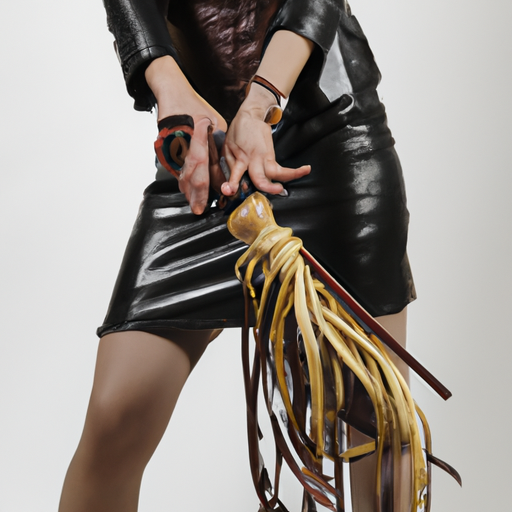Title: Exploring the Intersections of crossdresser bondage and Other Fetishes or Kinks

Introduction:
In the vast and diverse realm of human sexuality, individuals may find themselves drawn to various fetishes and kinks that align with their desires and fantasies. One such area of exploration is crossdresser bondage, which can intersect with other fetishes or kinks, creating unique and exciting experiences. In this blog post, we aim to delve into the intersections of crossdresser bondage with other fetishes or kinks, exploring the potential connections and boundaries that exist within this realm.
Understanding Crossdresser Bondage:
Crossdresser bondage refers to the practice of combining elements of crossdressing with bondage, where individuals enjoy the sensation of being tied up, restrained, or dominated while dressed in clothing traditionally associated with a different gender. Crossdresser bondage offers a unique blend of power dynamics, gender exploration, and sensory stimulation, making it an appealing choice for those who find pleasure in both crossdressing and bondage.
Intersections with Other Fetishes or Kinks:
Dominance and Submission (D/s):
The power dynamics inherent in crossdresser bondage can intersect with dominant and submissive tendencies. For some, the act of crossdressing itself may be submissive, while the bondage component adds an additional layer of power exchange. This intersection allows individuals to explore their desires for dominance or submission while incorporating elements of crossdressing that bring them pleasure.
Roleplay and Fantasy:
Crossdresser bondage can also intersect with roleplay and fantasy. By assuming a different gender identity through crossdressing, individuals can immerse themselves in a role or scenario that aligns with their fantasies. Whether it be a strict schoolteacher, a seductive secretary, or any other character, the combination of crossdressing and bondage can heighten the intensity of the roleplay experience, enabling individuals to fully embrace their desired fantasies.
Sensory Stimulation:
The use of various materials and accessories in crossdresser bondage can stimulate multiple senses, resulting in a heightened erotic experience. The feel of soft fabrics against the skin, the sound of ropes tightening, or the taste of anticipation can all contribute to a sensory-rich encounter. This intersection of sensory stimulation with crossdresser bondage amplifies the pleasure derived from the experience, further enhancing the overall erotic journey.
Exhibitionism and Voyeurism:
For some individuals, the combination of crossdresser bondage with exhibitionism or voyeurism can create a thrilling and arousing experience. Whether it involves being watched while engaging in crossdresser bondage or observing others in a similar scenario, this intersection allows individuals to explore their desires for public display or hidden observation.
Conclusion:
The world of fetishes and kinks is vast and ever-evolving, offering individuals an opportunity to explore their desires and fantasies in a consensual and respectful manner. Crossdresser bondage, as a niche within this realm, intersects with various other fetishes and kinks, providing a unique and personalized experience for those who engage in it. By exploring the intersections with dominance and submission, roleplay and fantasy, sensory stimulation, and exhibitionism or voyeurism, individuals can further enhance their experiences and tap into the depths of their desires.
It is important to emphasize the significance of clear and open communication, consent, and respect when exploring these intersections. As with any fetish or kink, individuals should always prioritize the well-being and boundaries of all parties involved, ensuring a safe and consensual experience. Official source.
Are there cultural or societal factors that influence body worship practices?
body worship: Unveiling Cultural and Societal Influences

In today’s society, the concept of body worship has become increasingly prevalent. From the pursuit of physical perfection to the glorification of certain body types, it’s clear that our cultural and societal factors play a significant role in shaping these practices. But what exactly are these influences, and how do they impact our perceptions of beauty and self-worth? In this blog post, we will delve into the depths of body worship and explore the cultural and societal factors that underpin this phenomenon.
One of the key cultural factors that influence body worship practices is the media. Through magazines, television, and social media platforms, we are bombarded with images of an idealized body. These images often depict a narrow definition of beauty, characterized by flawless skin, slender figures, and chiseled features. This constant exposure to such standards can lead to feelings of inadequacy, as individuals strive to conform to these unrealistic ideals. As a result, body worship practices, such as excessive exercise, extreme dieting, and even cosmetic surgeries, become the norm in an attempt to attain this unattainable perfection.
Moreover, societal pressures also contribute to the prevalence of body worship. In many cultures, there exists a deep-rooted belief that physical appearance is directly linked to one’s worth and success. This notion is perpetuated by societal norms and expectations, which dictate that attractiveness is a prerequisite for acceptance, love, and professional success. As a result, individuals may feel compelled to engage in body worship practices as a means to fit in and meet these societal expectations.
The impact of body worship practices goes beyond individual self-perception. It extends to the broader cultural values and beliefs that shape our society. For instance, in Western cultures, thinness is often associated with discipline, self-control, and desirability. On the other hand, in certain African cultures, voluptuousness symbolizes fertility and abundance. These cultural norms influence not only individual body worship practices but also the collective perception of beauty within a given society.
It is crucial to recognize that body worship practices can have detrimental effects on both physical and mental well-being. The relentless pursuit of an idealized body often leads to body dysmorphia, eating disorders, and low self-esteem. Furthermore, these practices perpetuate harmful stereotypes, reinforcing the idea that there is only one acceptable form of beauty. This narrow focus on physical appearance limits our understanding and appreciation of diverse bodies and ultimately hinders our ability to embrace true self-acceptance.
So, what can we do to challenge and reshape these cultural and societal influences? Firstly, we must start by promoting body positivity and inclusivity. This involves celebrating bodies of all shapes, sizes, and colors, and recognizing that beauty is subjective and multifaceted. By shifting the focus from external appearances to inner qualities and achievements, we can redefine our understanding of self-worth.
Additionally, we need to foster critical thinking and media literacy skills. By questioning the images and messages we consume, we become more discerning consumers of media. We can challenge the unrealistic beauty standards perpetuated by the media and advocate for the representation of diverse bodies and experiences.
Ultimately, dismantling the cultural and societal influences that fuel body worship practices requires a collective effort. By promoting self-acceptance, challenging harmful beauty norms, and fostering inclusivity, we can create a world where body worship is replaced with body appreciation. Let us strive to celebrate the uniqueness of every body and embrace the beauty that lies beyond the surface.